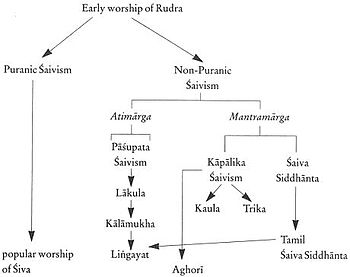迦波釐
迦波釐[1](Kāpālika)屬於怛特羅密教,是一個印度的非往世书式苦行濕婆教派。[2][3]

| 此條目翻譯自其他語言維基百科,需要相關領域的編者協助校對翻譯。 |
Kāpālika這個詞来源于嘎巴拉(kapala,头骨之意),意思是“骷髅人”。該教派崇拜湿婆,传统上會携带一个頂端綴有頭骨的三叉戟(khatvanga)和一个中空的颅骨作为乞讨缽[2][3]。他们會通过模仿陪臚的行为和特征以崇拜祂[2][4],包括用火化場的骨灰塗抹自己的身體[2],將頭髮留長、綁脏辫[2],并用血、肉、酒和性狂欢进行仪式[2][3]。
歷史 编辑
迦波釐現在已經消失,其历史可以追溯到公元8世纪。根据大衛·洛倫森(David Lorenzen)的说法,关于迦波釐的資料很少,他們的形象可以在虛構文學(見下文)或其他厭惡他們的教派的記載中見到[5],例如許多印度的文本記載,迦波釐有自由飲酒的習慣[6]。玄奘在他的回忆录(地理位置大致於现在巴基斯坦西北部)中写道,佛教徒与赤身裸体的苦行者生活在一起,他们用灰烬覆盖自己,头上戴着骨环。但玄奘沒有明確的說這群苦行者究竟屬於什麼教派,後世学者認為這些苦行者可能屬於迦波釐,也有可能是天衣派耆那教徒或獸主派[7]。
洛倫森说,迦波釐更像是寺院制度,而不是具有文本教义的教派[8]。迦波釐的传统衍生了Kulamārga教派,这是濕婆教密宗的分支,保留了迦波釐的一些特征。 [9]金刚乘佛教中有一些迦波釐的修持方法,學者們對於究竟是迦波釐影響了金剛乘,還是金剛乘影響了迦波釐尚未有共識。 [10]今天,迦波釐的传统保存在其濕婆教的分支中,包括阿格里教派、Kaula教派和喀什米爾濕婆教派。
文学形象 编辑
馬克·迪茨科夫斯基(Dyczkowski,1988: p.26)认为哈拉(Hāla,一名國王)的俗语诗《Gaha Sattasai》是现存最早关于迦波釐的記載之一:
最早提到迦波釐的地方之一是在哈拉(Hāla)的梵文诗集《Gāthā Saptaśati》 (公元3-5世纪)中的一首詩,其中描述了一位年轻的女迦波釐用情人葬礼柴堆的灰烬涂抹自己。 伐罗诃密希罗(公元500-575年)不止一次提到迦波釐,所以可以確認他們在公元6世紀就存在了。事实上,从那时起,梵文中開始普遍的提到迦波釐. . . [11]
參見 编辑
延伸阅读 编辑
- 《Dictionary of Hindu Lore and Legend》ISBN 0-500-51088-1. Anna L. Dallapiccola . 倫敦: Thames & Hudson, 2002。
- 《Kapalikas and Kalamukhas: Two Lost Saivite Sects》ISBN 0-520-01842-7. David N. Lorenzen. 伯克利:加州大學出版社,1972。
- 《Mattavilasaprahasana》. Māni Mādhava Chakyār。
- 《Ankalaparamecuvari: a goddess of Tamilnadu, her myths and cult》ISBN 3-515-04702-6. Eveline Meyer. 斯图加特:Steiner Verlag Wiesbaden GMBH, 1986。
- 《The Blackwell Companion to Hinduism.》 莫尔登:布萊克威爾,2003。
- 《Indian Esoteric Buddhism》. Ronald Davidson. 哥倫比亞大學出版社,2002。
参考資料 编辑
- ^ Ernest John Eitel (编). Hand-book of Chinese Buddhism: Being a Sanskrit-Chinese Dictionary with Vocabularies of Buddhist Terms in Pali, Singhalese, Siamese, Burmese, Tibetan, Mongolian and Japanese. The Rosen Publishing Group. 1904: 70 [2024-04-28].
- ^ 2.0 2.1 2.2 2.3 2.4 2.5 James G. Lochtefeld. The Illustrated Encyclopedia of Hinduism, Volume 1. The Rosen Publishing Group. 2001: 349 [2021-07-25]. ISBN 978-0-8239-3179-8. (原始内容存档于2021-05-22).
- ^ 3.0 3.1 3.2 Gavin Flood. The Blackwell Companion to Hinduism. John Wiley & Sons. 2008: 212–213 [2021-07-25]. ISBN 978-0-470-99868-7. (原始内容存档于2019-12-23).
- ^ David N. Lorenzen. The Kāpālikas and Kālāmukhas: Two Lost Śaivite Sects. University of California Press. 1972: 4 [2021-07-25]. ISBN 978-0-520-01842-6. (原始内容存档于2017-02-05).
- ^ David N. Lorenzen. The Kāpālikas and Kālāmukhas: Two Lost Śaivite Sects. University of California Press. 1972: xii [2021-07-25]. ISBN 978-0-520-01842-6. (原始内容存档于2017-02-05).
- ^ David N. Lorenzen. The Kāpālikas and Kālāmukhas: Two Lost Śaivite Sects. University of California Press. 1972: 5 [2021-07-25]. ISBN 978-0-520-01842-6. (原始内容存档于2017-02-05).
- ^ David N. Lorenzen. The Kāpālikas and Kālāmukhas: Two Lost Śaivite Sects. University of California Press. 1972: 15–16 [2021-07-25]. ISBN 978-0-520-01842-6. (原始内容存档于2017-02-05).
- ^ David N. Lorenzen. The Kāpālikas and Kālāmukhas: Two Lost Śaivite Sects. University of California Press. 1972: xi [2021-07-25]. ISBN 978-0-520-01842-6. (原始内容存档于2017-02-05).
- ^ Sanderson, Alexis. "The Śaiva Literature." (页面存档备份,存于互联网档案馆) Journal of Indological Studies (Kyoto), Nos. 24 & 25 (2012–2013), 2014, pp.4-5, 11, 57.
- ^ Ronald Davidson (2002), Indian Esoteric Buddhism, Columbia University Press. pages 202-218
- ^ Dyczkowski, Mark S. G. (1988). The canon of the Śaivāgama and The Kubjikā Tantras of the western Kaula tradition. SUNY series in Kashmir Śaivism. SUNY Press. ISBN 0-88706-494-9, ISBN 978-0-88706-494-4 Source: (accessed: Thursday February 4, 2010)